The vehicles of the second 3-series from BMW are designated with the works code BMW E30. The Z1 Roadster model, derived from this series, had the same factory code.
The E30 was produced in far more variants than the predecessor, the BMW E21, which was only offered with two doors. The second 3-series came on the market at the end of 1982 and was also available as a four-door from September 1983. In autumn 1985 – 670,000 E30s were sold by August 1985 – the full convertible (without roll bar) and the first M3 were presented. As the second BMW diesel car after the 524td diesel model presented in 1983, the smaller 324d entered the BMW range in 1985. A station wagon variant with the name Touring, already used in the hatchback model of the BMW 02, followed for the major facelift in September 1987. The E30 model was manufactured 2.34 million times in the Munich and Regensburg plants.
The E30 series replaced the vehicles of the first 3 series E21 in November 1982. The design of the first 3 series comes from Paul Bracq and was further developed in the E30 under Claus Luthe. The executive exterior designer was Boyke Boyer. Production (not delivery) of the first two-door models (323i) began in December 1981, the 320i from January 1982 and the 316 / 318i from March 1982. The four-door sedans were manufactured from January 1983.
The Baur Topcabriolet, which is also based on it, was part of the model range from the beginning of 1983 until the end of production of the two-door sedans. In January 1986, the range was expanded to include the convertible with a fully retractable top and without a roll bar, and in 1987 the Kombi touring was launched on the market. The first generation of the BMW M3, which has been available since 1986 and was later used successfully in the DTM, is characterized by low numbers.
On the drive side, it initially remained largely with the engines known from the E21. With the six-cylinder engines, however, the mixture preparation was changed: with the six-cylinder variants, the Bosch L-Jetronic series was now available, with the predecessor the 320 was only available with a carburettor, the 323i with a Bosch K-Jetronic. With the 325e (e pronounced eta) a particularly high-torque and minimal variant was introduced parallel to the BMW 525e E28. In addition, with the development of the 324d and the 324td, which was available two years later, a diesel engine with or without a turbocharger, also parallel to the BMW 524d / 524td E28, went into production for the first time in BMW history. Animated by the success of the competition, especially Audi with its quattro drive, BMW developed an all-wheel drive, which was then used for the first time in the company’s history in a civilian version of the 325iX in 1985 (from 1937 there was already a light standard car of the Wehrmacht of the type BMW 325 an all-wheel drive BMW).
Externally, the four- and six-cylinder models or models with a displacement of two liters or more could no longer be distinguished as clearly as with the predecessor E21, since all E30s are now tied to double headlights as standard. The only, if not very noticeable, distinguishing feature was the different design of the rear silencer, which was free on the models up to 08/1987 due to the reduced rear apron. The four-cylinder with the M10 engines (316 66 kW, 316i 75 kW, 318i 75/77 kW) were equipped with a single-flow, round cross-section, the six-cylinder (320i 92 kW, 323i, 325e 90 kW) received a larger, oval one and also single-flow rear silencer. The later six-cylinder units were fitted with systems that were identical in size until they were no longer in production. With the use of the M40 / M42 motors, the only difference to the M20 variants was a single- to double-flow system with different pipe diameters.
BMW E30 petrol engines:

BMW E3o Diesel engines

In the interior, the differences, especially in the fabric upholstery, became larger, if not serious. In contrast to the one-piece door panels completely covered with artificial leather, the six-cylinder models were given others with a fabric or velor insert. In comparison, the seat cushions were more elaborate and of a little higher quality. The seat cheeks of the six-cylinder were covered with smooth velor fabric and the seat center panels with textured fabric, while the four-cylinder were made of simpler, but also high-quality fabrics with a uniform pattern. In addition, the 6-cylinder models had a tachometer with a digital clock (later an analog clock) in the center console as well as the “Check-Control” above the inside mirror as standard. This equipment feature, integrated into the headliner with an additional black cover and smaller black sun visors, was used to monitor important electrical vehicle functions and the fluid levels.
The BMW E30 was manufactured as a two- and four-door sedan until April 1991. Production of the convertible ended in April 1993. The Touring was the last variant of the E30 series to be offered until April 1994.
In South Africa, production of the right-hand drive two- and four-door models did not end until February 1992.
The successor model presented in September 1990 received the factory code E36.

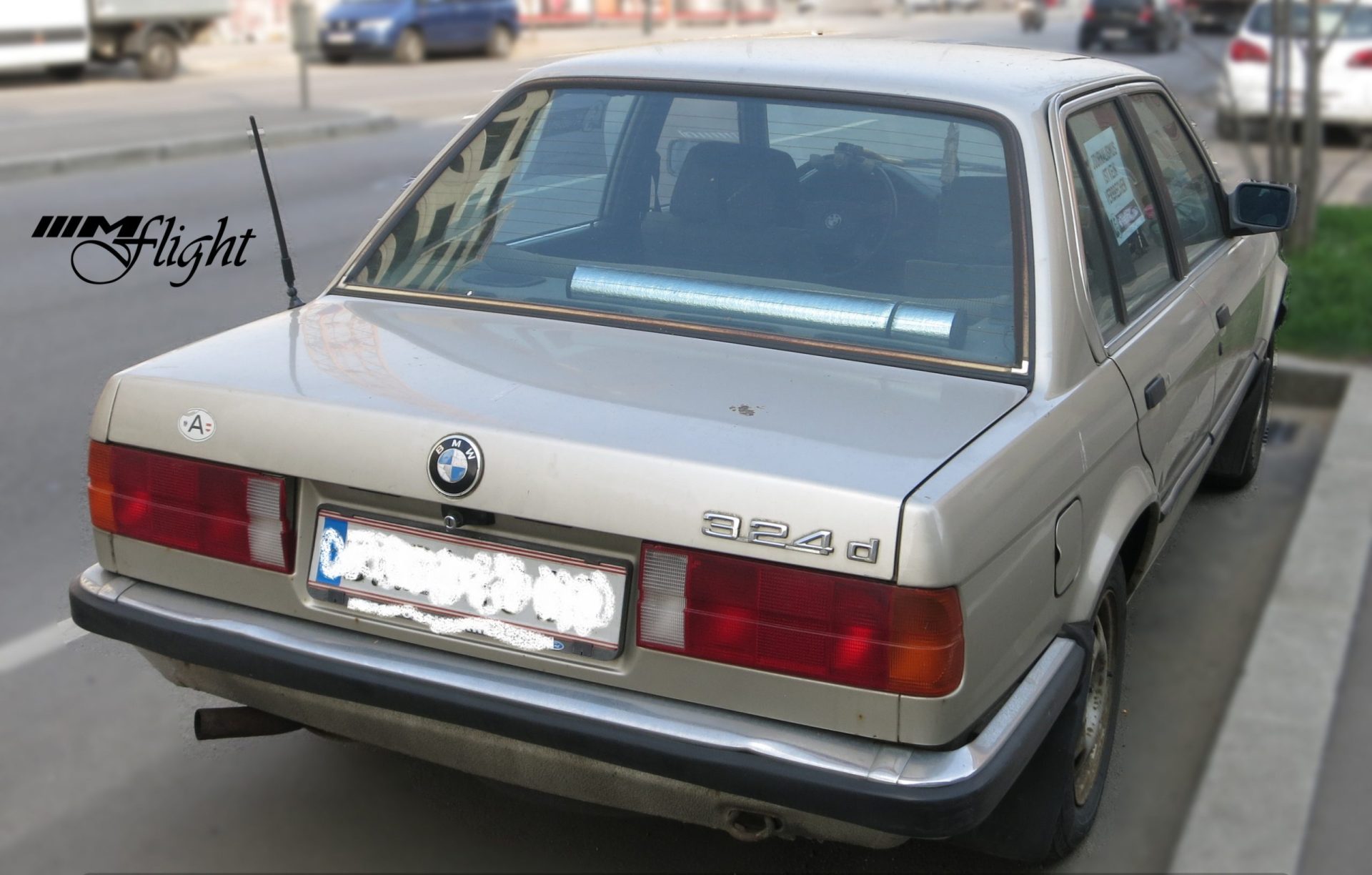
BMW E30 318i 4 door pre facelift with chrome bumpers BMW E30 4-door pre facelift, rear view with chrome bumpers
The first facelift was made in September 1985. The most obvious external innovation was the change in the front apron, which was now made in one piece and vertically. The front spoiler, which is slightly shaped downwards in the direction of travel, was finally pulled further under the engine with a gentle curve. Until then, the two-part front apron with the associated smaller spoiler formed an escape from the headlight grille. The 195 / 60R14 tires have been replaced by the 195 / 65R14 format, which has a larger cross-section. The rockfall protection that is now consistently applied to the rear panel below the bumper is relatively inconspicuous, previously on the right and left only from the wheel arch to just above the body joint of the rear panel / side wall. Changed upholstery fabrics found their way into the interior, the difference between the four-cylinder and the six-cylinder was now smaller, it consisted only of differently patterned seat center panels, and smooth velor was now always used on the outside. In addition, the “Pepita” fabric upholstery was introduced, which was available for all variants. The differences in the door panels remained. The most striking change is also the belt guides at the back. The redirection on the C-pillar was omitted and the lap belt with the brackets for the belt locks was now mounted the other way around. The parcel shelf has been adapted to the rear seat bench, which has been minimally changed in the upper area, just like for the three-point seat belts, which are now flat. These changes in the interior were retained until the sedans were no longer in production.

BMW E30 facelift front view

BMW E30 facelift rear view
In September 1987, BMW carried out a major facelift on the two- and four-door sedans, the convertible only received the external facelift in 1990, whereas the M3 was externally built as a pre-facelift variant until the end of production in 1991, with the exception of the headlights. which were converted to lens technology at the same time as the facelift of the convertible. In addition, the Touring station wagon was initially included in the range as the 320i and 325i, while the 325e model was no longer available.
The most noticeable changes were a newly designed front apron, the chrome bumpers gave way to the more voluminous and plastic-made anthracite-colored bumpers, which were painted in the body color on request (part of the “Shadow-Line” special equipment, see below, otherwise for an extra charge on special request) , with the bumper inserts generally remaining black. The bumpers now withstood bumps up to 4 km / h undamaged. Their mountings, called impact boxes because of their shock-absorbing functionality, protect the vehicle frame from deformation up to 15 km / h. The chrome trim, for example on the front and rear windows and around the door windows (two-door rear around the rear window on the side) gave way to black plastic parts or black-coated aluminum profiles. The side bumper strips were now one-piece and without a chrome strip. The rain gutter and the window slot strips remained in chrome.
The rear lights and the rear apron have been enlarged. The new DE main headlights had reflectors in a triple ellipsoid shape. The rear wheel cutout has been reduced in size and given the shape that has been found on the convertible since production began. The tank volume grew from 55 l to 64 l (only 6-cylinder sedan) or to 62 l (works convertible and 318i Edition Executive). Since the facelift, all petrol engines have been equipped with a regulated catalytic converter as standard.
The interior remained largely unchanged, the type of seat upholstery was retained, only the colors in their nuances and names were changed. New upholstery fabrics, interior and exterior paintwork that differed from the series, were offered for various “edition models” (Edition Executive for sedans 318i – 325i, last edition for sedan / convertible 325i, design edition for convertible 318i and touring 316i / 318i) in order to promote sales until the end of production of the respective body variant. Special fabric / color combinations were available for the M3 and 318is. The selection of special equipment has been expanded.
In the case of the export models for the US market, no model updates were initially carried out. In 1988 these were also given new, shortened bumpers, but they were chrome-plated. In 1989 plastic bumpers were also introduced here.

BMW E30 Standart Seat

BMW E30 Standart Interior

BMW E30 Sports seats with the “Übercaro Desaign ”

BMW E30 Sports seats with “Krährnfuß Design”

BMW E30 Sport seats from the “Last Edition Series”

BMW E30 Sports seats from the “Last Edition Serie” here with yellow piping edge

BMW E30 sports seats from the “Last Edition Series” with red piping
|
Werkscode |
Produktionsbeginn |
Produktionsende |
|
|---|---|---|---|
|
zweitürige Limousine |
E30/2 | Dezember 1981 | April 1991 |
|
viertürige Limousine |
E30/4 | Januar 1983 | April 1991 |
| E30/2Cab (Basis zweitürige Limousine, Serie) E30/4Cab (Basis viertürige Limousine, Prototyp) |
Februar 1983 | April 1991 | |
| E30/2C | Juli 1985 | April 1993 | |
| E30/2SC | Juni 1988 | Juni 1991 | |
| E30/2S | Februar 1986 | Dezember 1990 | |
|
Touring (Kombi) |
E30/5 | Juli 1987 | April 1994 |
| E30/Z (Vorserie 80 Stück); Serie: Z1 | Juli 1988 | Juni 1991 | |
|
Allradvarianten (iX) |
E30/16 | Februar 1985 | Februar 1991 |
From the beginning of 1983, the BMW E30 was converted into a convertible in small numbers exclusively as a two-door model by the Stuttgart-based company Baur and sold by the BMW dealer network. All petrol engines could be selected. However, the Baur TC (compare its predecessor BMW E21 Baur TC or BMW 02 Baur TC) was not a full convertible. So the side window frames and a roll bar remained. The stable roof section over the front seats could be opened like a targa roof, the rear roof area could be opened like a landaulet. A top convertible based on the four-door sedan was created by Baur as a one-off in 1988. The vehicle, which was never officially presented, was in the company’s own vehicle exhibition for several years and is now owned by a private BMW collector.

Baur Top Cabrio pre Face Lift

Baur Top Cabrio Face Lift

Baur Top Cabrio 4 door
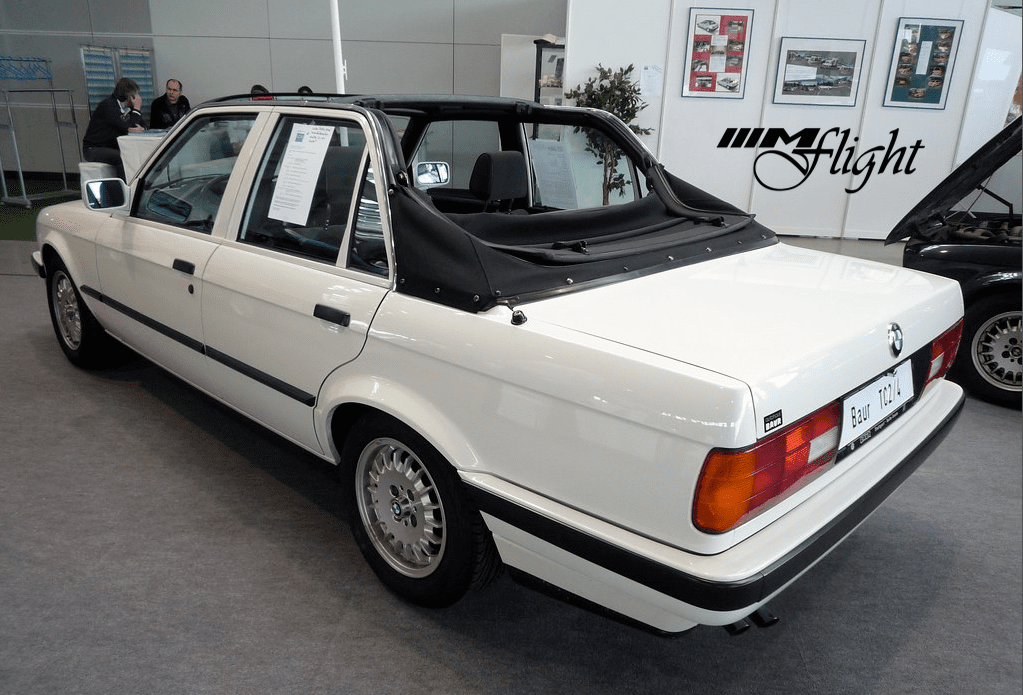
Baur Top Cabrio 4 door
Convertible
After 15 years without a convertible in the BMW model range, the open-top BMW 325i was presented at the 1985 IAA. Later, the 320i (from 1987) and the 318i (with the facelift to the 91 model) rounded off the lower end of the convertible range.
In September 1988 the M3 Cabrio appeared, which was only built 786 times between June 1988 and June 1991. In the USA the 318i convertible was delivered with the four-valve M42 engine (construction period July 1990 to December 1992). To make the cabriolet torsion-resistant, the body, sills and the window frame were reinforced. This increased the weight of the open vehicle by around 125 kg compared to its closed counterpart. The soft top could later be lowered electrically (with the M3 series) (initially electro-hydraulic, later electric motor) and disappeared under a flat convertible top flap. Also available was a hardtop with vinyl cover from BMW and a hardtop from Wiesmann that could be painted in the same color as the car.
With the six-cylinder versions from 320i onwards, the bumpers and exterior mirrors were painted in the same color as the car from the body-side facelift in autumn 1990.
M3
The BMW M3 initially served as the base vehicle for homologation in Group A and became one of the most successful racing touring cars of all time, for example in the DTM. The vehicle was developed and produced by BMW M GmbH, a subsidiary of BMW.

DTM 1988

No, Timo Clock didn’t really race in the M3 E30 in 1988 …
This photo was taken on the occasion of the 500 DTM race at the Lausitzring.

The M3 E30 is still used in numerous races today.
The BMW M3 was available as a two-door sedan and a convertible. The wheelbase was shortened by 5 mm compared to the other versions. For both variants, the body has exhibited fenders for the improved and widened chassis with a larger brake system and 5-hole hubs instead of the 4 and only on the sedan a rear window attachment with a flat rear window including a raised plastic trunk lid with spoiler. The bodywork changes corresponded to the zeitgeist and the main reason, especially in the case of the sedan, was an improvement in aerodynamics. The engine used was a four-cylinder four-valve engine with the designation S14 derived from the engine block of the BMW M10 and cylinder head of the original six-cylinder engine BMW M88 used in the BMW M1 (with 2302 cm³ 143–158 kW (195–220 hp), later 2453 cm³ (175 kW / 238 PS in Sport Evolution 2)). The concept for this engine comes from Paul Rosche, also known as “Nocken-Paule”, who was originally only transferred to camshaft development due to a lack of staff. The high-revving engine developed initially without cat. 147 kW (200 hp) and from 1987 with cat. 143 kW (195 hp). In the then DTM as a touring racing car even up to 276 kW (375 PS).



BMW E30 M3 Sport Evolution Rearwing
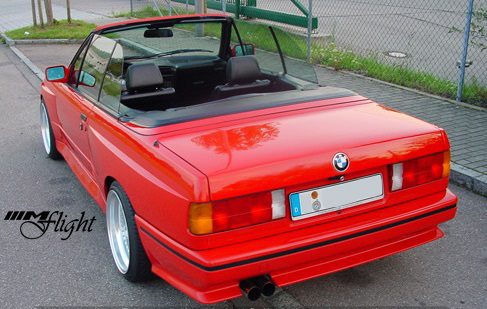
Only 786 pieces of the BMW E30 M3 Convertible were built.
Further aditional information on the BMW M3 E30 special models can be found in our article BMW E30 M3 special models under the following link:
and in a separate article here on our site.
In export models for the Italian market, this engine was reduced to two liters due to the local tax laws and offered as a 320is with 141 kW (192 hp) in the normal E30 body without the chassis-specific changes to the M3. The BMW 320iS was built around 3,600 times, of which around 1,100 were built as a 4-door sedan, which could optionally be equipped with the M-Technik package 2.

The so-called “Italo M3” had an M3 engine with 192 hp that had been reduced to 2 liters

The so-called “Italo M3” had to do without the angular extensions and the shortened chassis. Instead he had the M Technik 2 package.
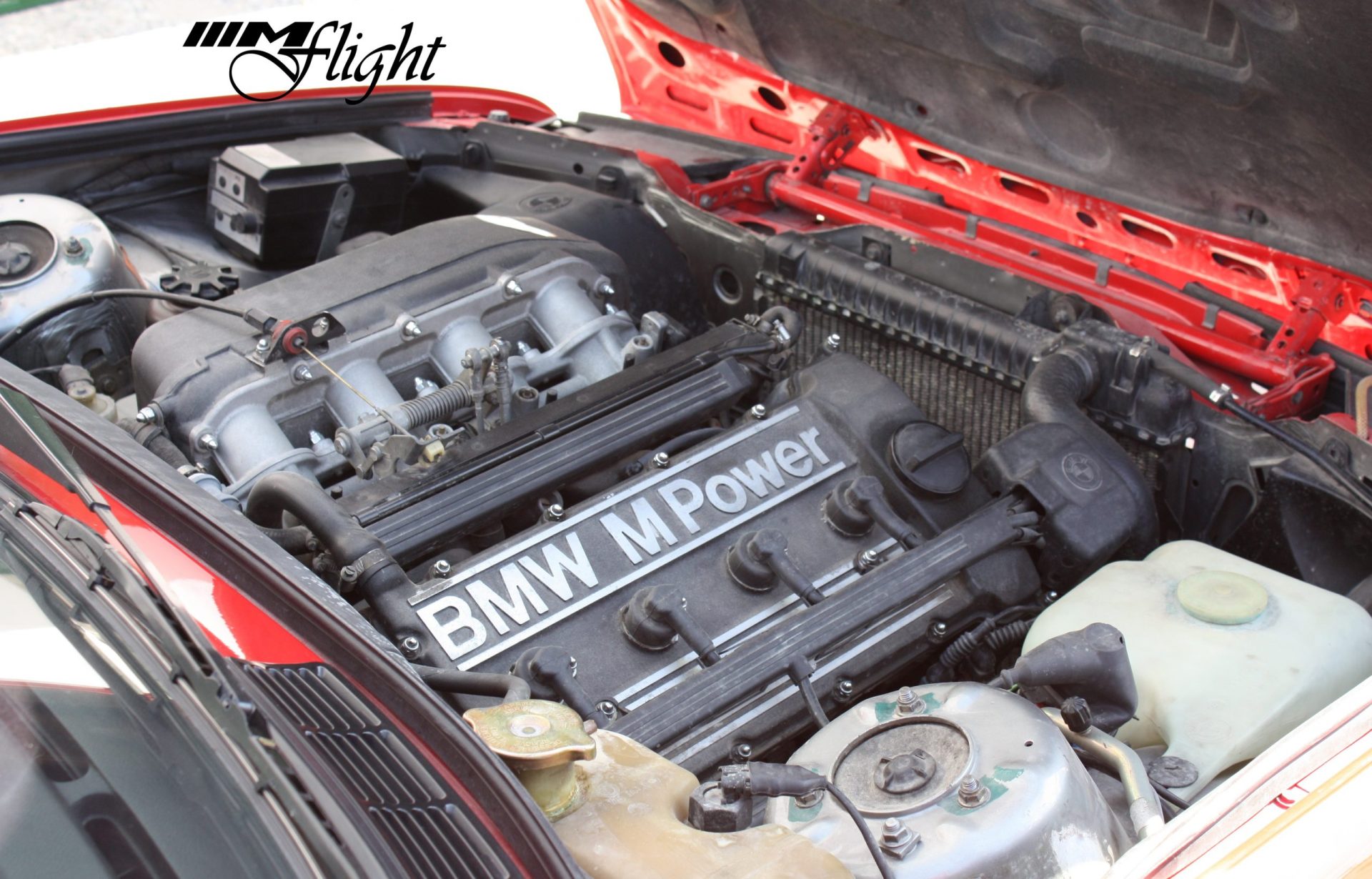
Externally, the S14 320IS engine of the Italo M3 can hardly be distinguished from the E30 M3 engine.
Touring
The station wagon variant based on the four-door sedan (internal E30 / 5) was presented in September 1987 at the beginning of the 1988 model year with the second facelift.
In contrast to its predecessor, the Touring of the 02 series, the 3 Series Touring was enthusiastically received by the target group. It was available as the 320i, 325i and 325ix, later followed by the 324td, 318i and also the small 316i. It is characterized by an almost level cargo area with a fine carpet and completely covered wheel arches with integrated storage compartments and boxes for the sound system. The back seat was split in half and foldable. A load compartment cover was part of the equipment, as was a wiper / washer system for the rear window. The wide taillights were fixed, the tailgate only reached the width of the license plate down to the level of the cargo area, which sometimes made loading and unloading difficult.
In the last few model years, the Touring range was rounded off by the Design Edition special models.
Production of the first 3 Series Touring ended in the spring of 1994.
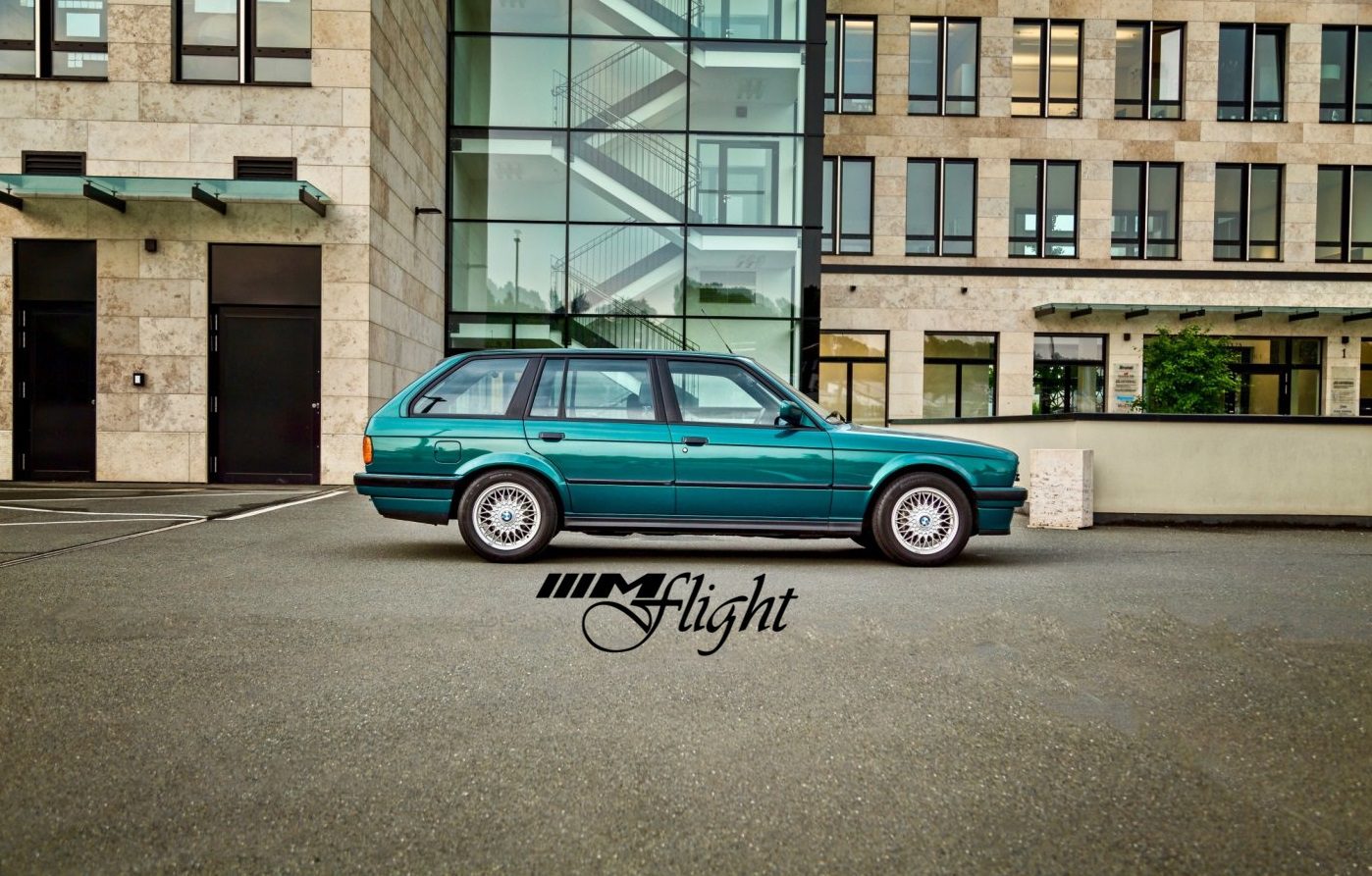
BMW E30 Touring
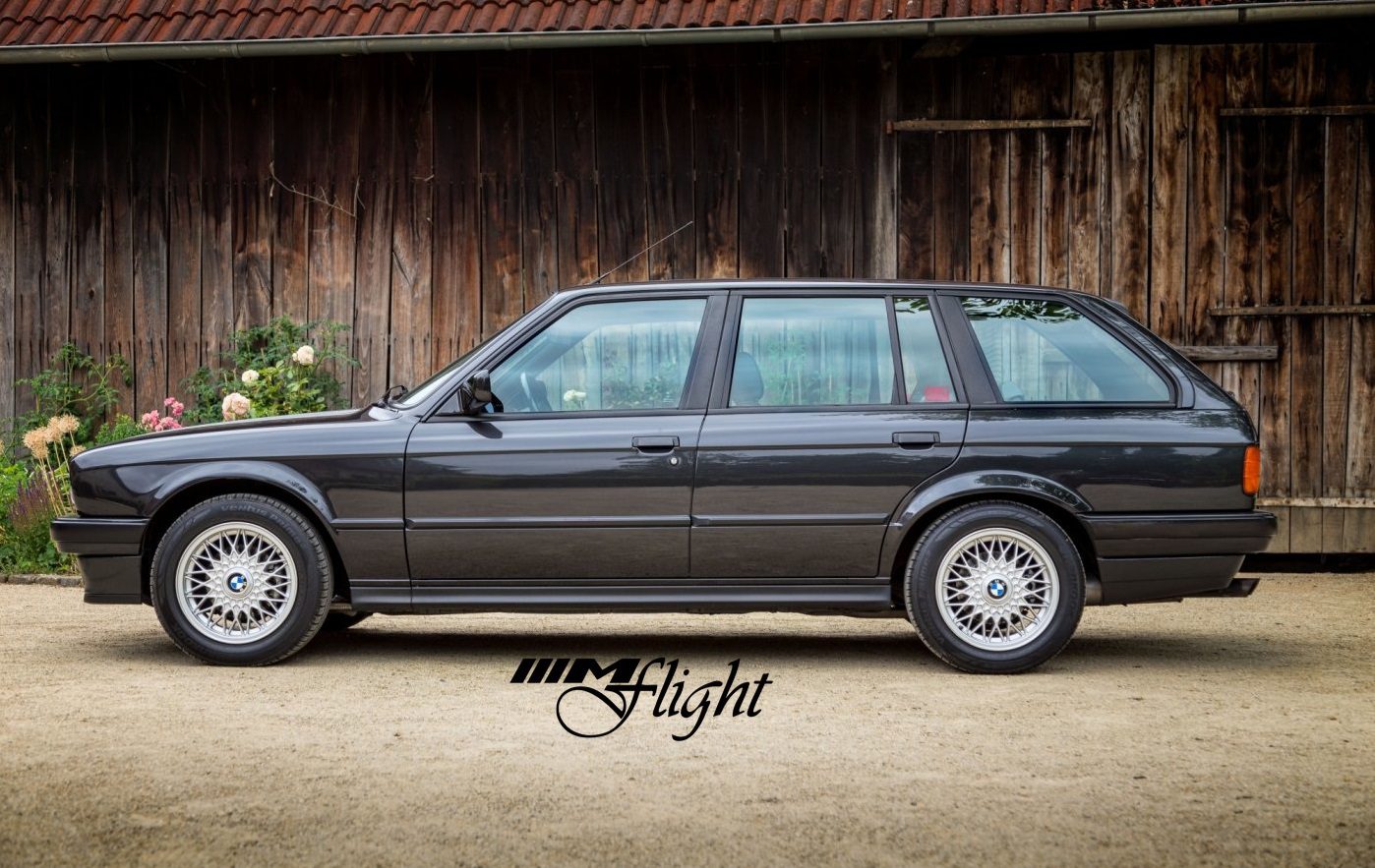
BMW E30 Touring

BMW E30 Touring

Bmw E30 Touring
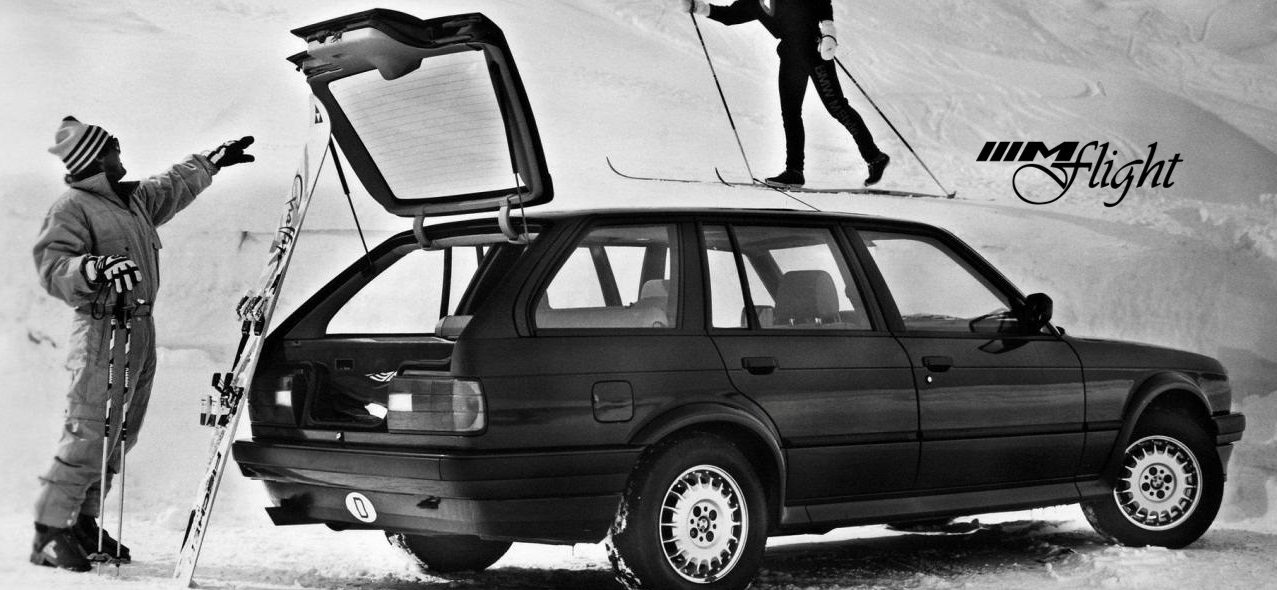
Advertising brochure BMW E30 Touring

Advertising brochure BMW E30 Touring
At the time, BMW AG hadn’t even planned to build the E30 as a touring variant. According to rumors, a BMW AG employee (Max Reisböck) is said to have privately converted a BMW sedan into a touring car in his spare time and drove it to work. In the parking lot, a board member is said to have noticed the vehicle parked there and then initiated the implementation of series production.
In fact, however, BMW reported in BMW’s own magazine “Edition Weiß blau” that the first E30 Touring based on the pre-facelift BMW e30 sedan were manufactured by Luchjenbroers in Holland before the factory employee (Max Reisböck). You can find a separate article about this here on our website.

The number 003 of the very first BMW E30 Touring manufactured by Luchjenbroers in Holland
Special series
320i Edition “S”
The 320i Edition “S” was built in 1985 as a limited special model. It was a diamond black metallic painted 2-door sedan with manual transmission.
The scope of equipment included:
- A front spoiler and a rear spoiler
- Shadowline, i.e. all chrome parts, except for the kidney grille, rain gutter and window sill, were blackened, even the radio antenna
- Green thermal insulation glazing
- Steel crank roof
- Sport leather steering wheel
- Leather gear knob
- Interior in anthracite
- M-Technic chassis with gas pressure shock absorbers and harder stabilizers
The models could be recognized by the specially polished 14-inch alloy wheels in the “Styling E30” design with 195/65 tires and the two decorative stripes on the side at the height of the “light edge”. As a novelty, the revised 320i engine with 129 hp and 174 Nm was installed instead of the 125 hp engine.

BMW E30 Edition S

BMW E30 Edition S
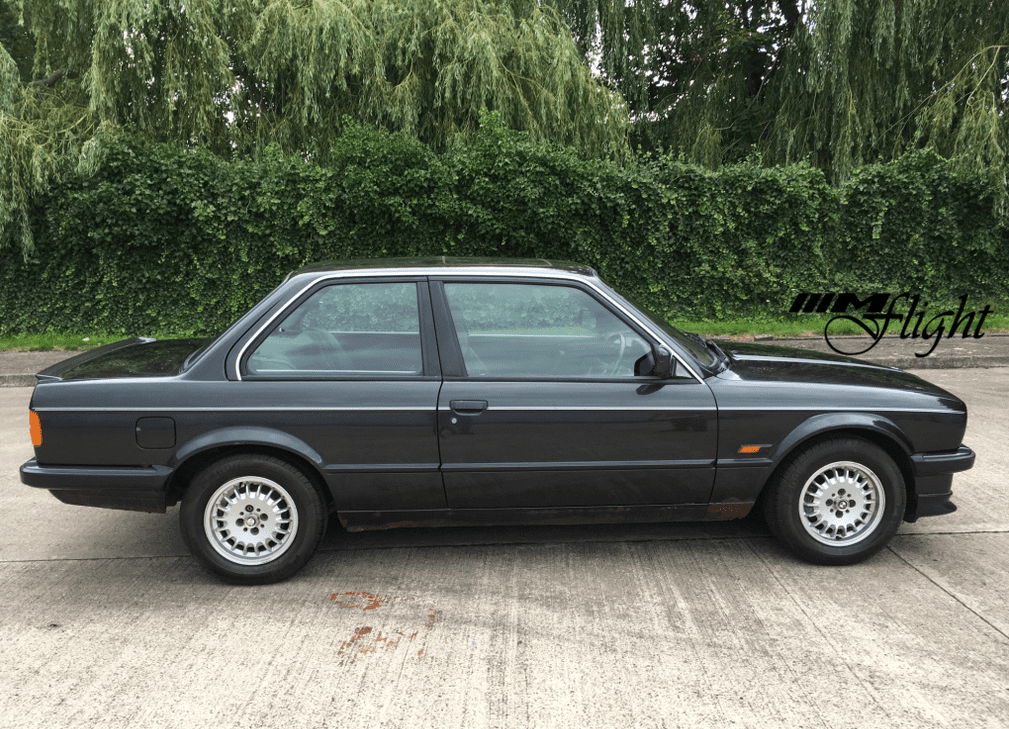
BMW E30 Edition S
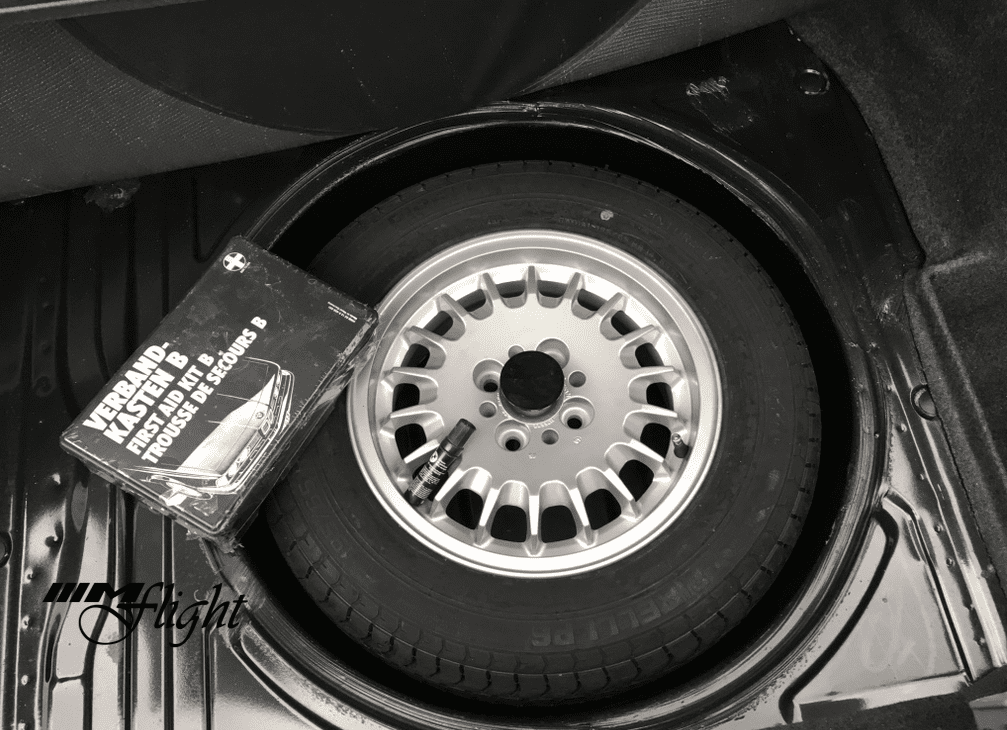
BMW E30 320i Edition S
 BMW E30 320i Edition S
BMW E30 320i Edition S
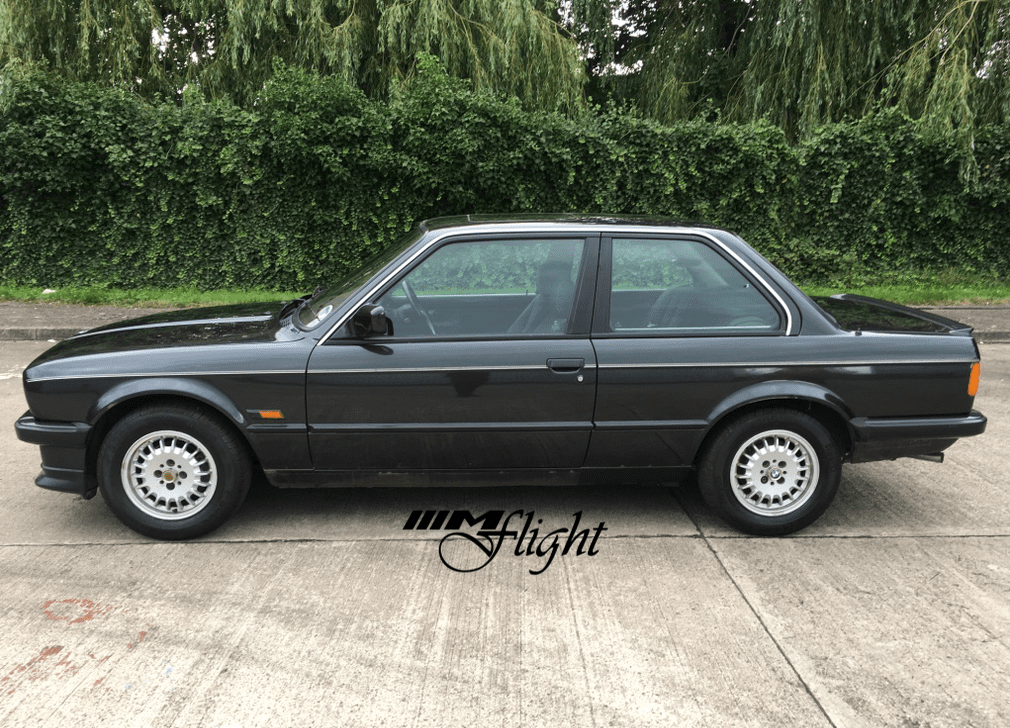
BMW E30 320i Edition S
318i edition
The 318i edition model was launched in May 1987 at the end of the “chrome era”. It was initially available as a two- and four-door sedan (at the usual surcharge for metallic paint) in the metallic colors salmon silver, dolphin, diamond black and from June also in the plain colors alpine white and vermilion. All chrome parts, except for the kidney grille, rain gutter and window sill, were blackened. The bumpers and exterior mirrors were painted in the same color as the car. In addition, a front spoiler was fitted in the same color as the car and a rear spoiler, which was always painted black, regardless of the exterior color. The standard chassis was replaced by the M-Technic chassis. Green heat protection glazing all round was part of the equipment package as well as the 3-spoke leather sports steering wheel, a leather gear knob, electrically adjustable right exterior mirror, light alloy wheels 6×14 ET35 in BMW design (“manhole cover”) with 195 / 65R14 tires and a tachometer with consumption indicator. The interior was kept in anthracite. The package price was DM 2,200.

BMW E30 318i Edition Prospekt

BMW E30 318i Edition Prospekt

BMW E30 318i Edition Prospekt

BMW E30 318i Edition Prospekt

BMW E30 318i Edition Brochure Message to dealers for internal use only

(dealer information) NOT for public use!
Edition Executive
At the end of the production of two- and four-door sedans, edition equipment was offered for the 318i, 320i, 325i, 325iX and 324td, which was characterized by numerous built-in extras. If the interior trim color is selected accordingly, the color-matched interior fittings that are only used here stand out, which were optionally processed in the colors silver or indigo (instead of the “usual” black). In contrast to the series, or the interior color anthracite, the entire center console, the lower parts of the dashboard, the B-pillar cladding, gear lever and handbrake bellows and, from 320i, the seat belts were also made in the interior color. In the case of six-cylinder models, the belts were finally provided with a dark edge. The upholstery fabrics for the six-cylinder were only available in the so-called “pinstripe velor”, which was used on the seat center panels and the textile door inserts. 318i models had different seat upholstery fabrics with about 0.5 cm wide horizontal stripes across the middle section in anthracite or indigo, depending on the upholstery color. The side bolsters were covered with smooth velor and, from the 320i, so was the rest of the seat. With the 318i, only the seats and the side bolsters were covered with it and, as is known from the standard models, the rest of it with black synthetic leather. The 6-cylinder petrol engine received a textile headliner, the 318 a headliner over the windshield (in the 6-cylinder series because of check control). Externally, all models were the only post-facelift models that had the closed (318i, 320i) or the open oil cooler cover (324td, 325i, 325iX) fitted in the body color ex works. This cover was always black on all other models.
The scope of equipment included from 318i Shadow-Line, BMW light alloy wheels 6Jx14 with 195 / 65R14, green heat-insulating glass, fog lights, a black exhaust cover, central locking, higher-quality upholstery and the significantly upgraded, color-matched interior, sports leather steering wheel, radio BMW Bavaria C II, Cassette holder, outside temperature display, and the larger 62 l tank, otherwise only used in the six-cylinder. From the 320i onwards, the equipment was enhanced by metallic paintwork, aerodynamic components painted in body color, BMW light alloy wheels 6J × 14 (324td), BMW light alloy wheels 6.5Jx14 in cross-spoke styling with painted wheel spider (325i also with a high-sheen rim edge), chrome-plated exhaust trims (except 324td) , Center armrest in the rear, radio BMW Bavaria C Reverse II, front electric windows, illuminated switch button emblem, automatic interior light, trunk lid trim and from 325i by electronic temperature control, for 325iX heating for the exterior mirrors including heated windscreen washer nozzles and driver’s door lock as well as seat heating, ski bag and headlight washer system .

BMW E30 Edition Executive
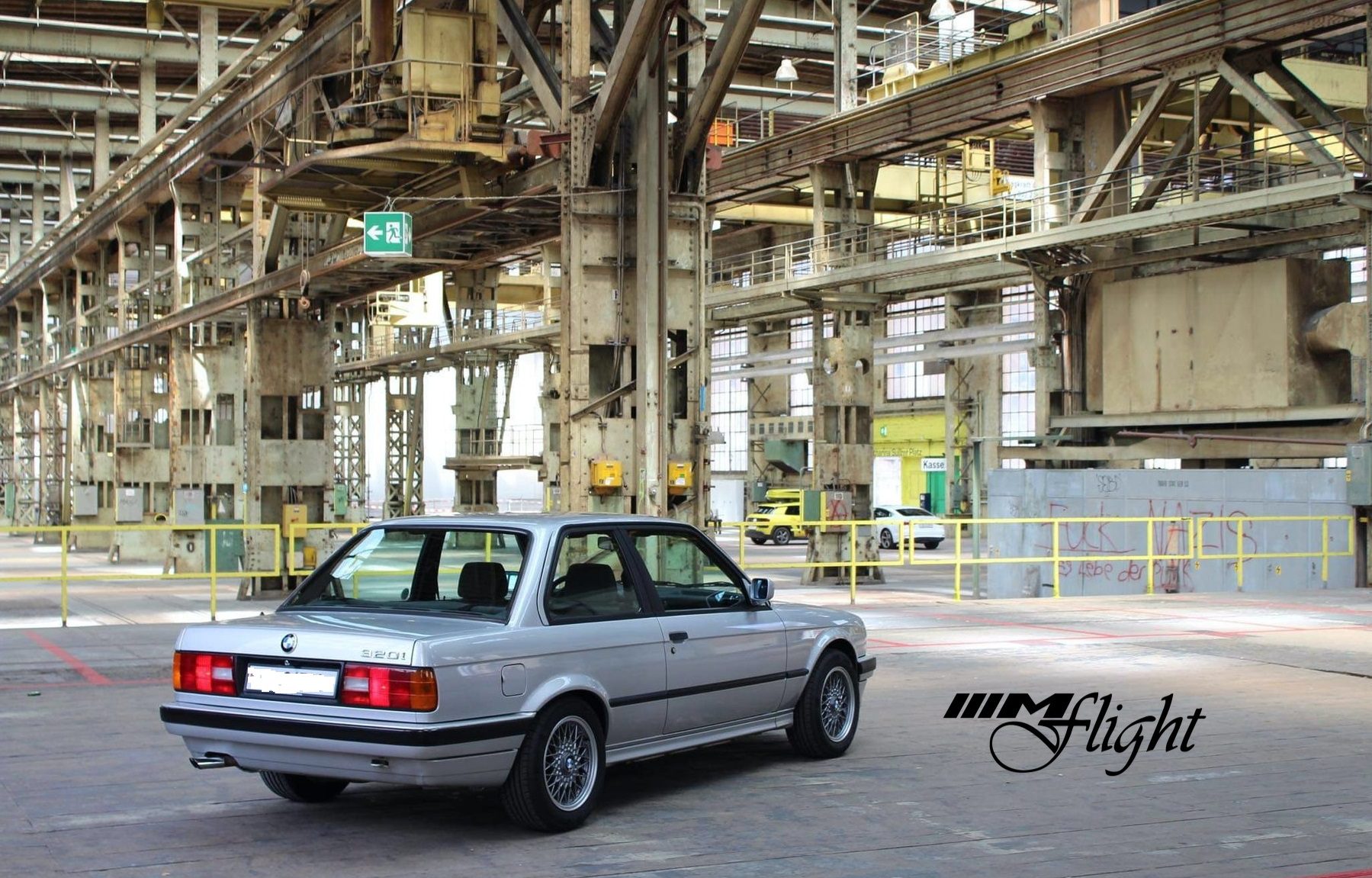
BMW E30 Edition Executive

BMW E30 Edition Executive Teileder

BMW E30 Edition Executive Teileder
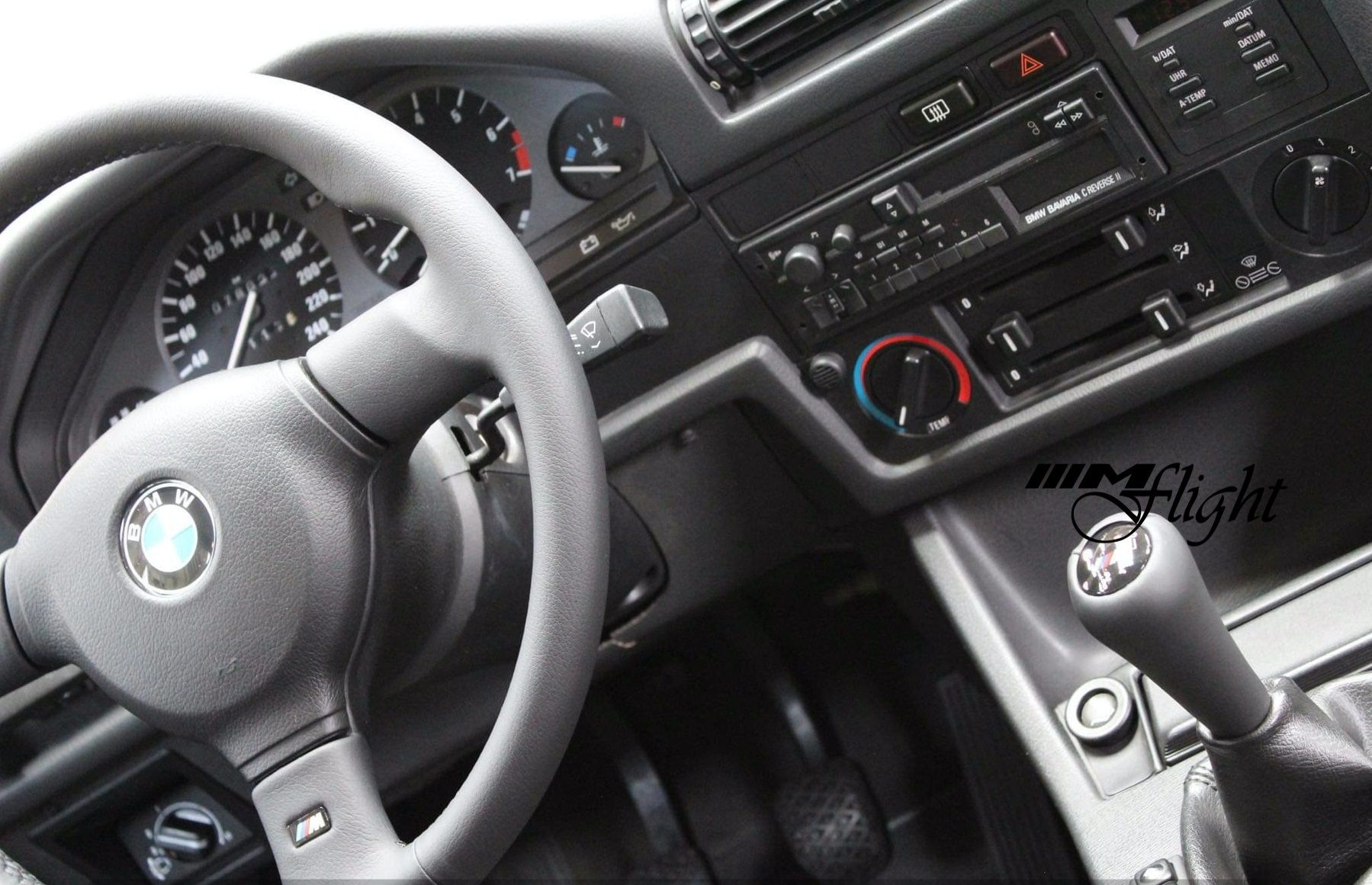
BMW E30 Edition Executive Teileder

BMW E30 Edition Executive mit nur Stoff

BMW E30 Edition Executive with Fabric
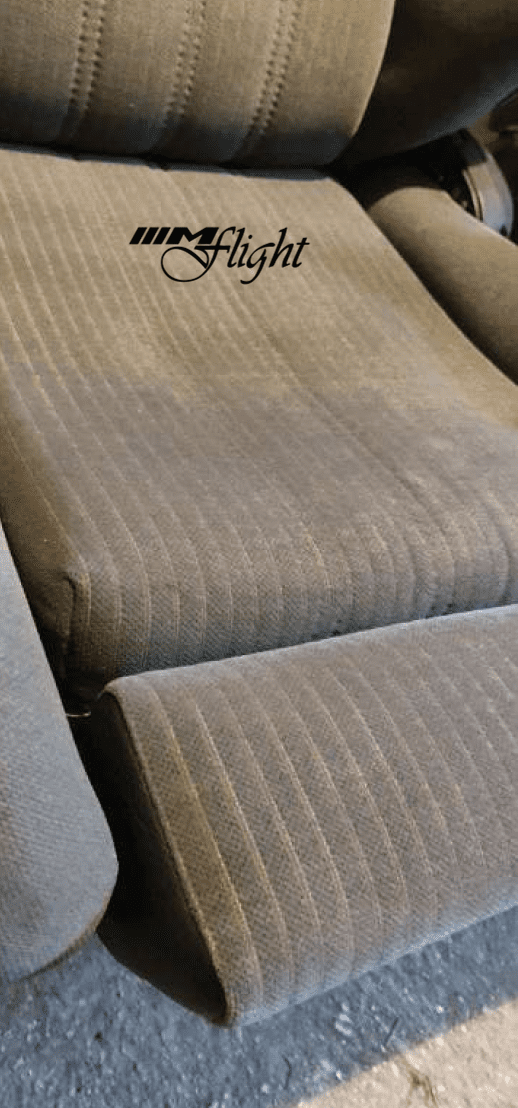
BMW E30 Edition Executive with Fabric

BMW E30 Edition Executive with Fabric

BMW E30 Edition Executive with Fabric
Design-Edition
In the last two years of construction, the Touring was only manufactured as the 316i and 318i and the convertible as the 318i and, in contrast to the standard models, was also offered with a particularly attractive and extensive “Design Edition” option. This was characterized by special paintwork and an interior that was matched to the exterior color.
As early as 1991, the 318i Cabrio appeared in a design edition in the special colors neon green and neon blue. The seat center panels / door panels were designed in neon green mottled or neon blue mottled to match the exterior color. In addition, the vehicles were upgraded with the following special equipment ex works: light alloy wheels, cross-spoke styling with 205/55 R15 tires, M Technic leather sports steering wheel / leather gear knob and Shadowline. In this first design edition, the rim stars were also painted in the same color as the car.
For the 1992 model year, the design edition was supplemented by the two additional colors Muggle red and Dayton purple and further upgraded with an expanded range of equipment (ABS, electric motorized top, M-Technic chassis, central locking).
At the end of 1992 there was the final edition of the 318i Design-Edition Cabrio with further improved equipment (Walknappa leather, bi-color, seat heating, fog lights, radio Bavaria C Reverse RDS) in the three colors Muggle red, Dayton violet and Mauritius blue with the corresponding colored seat center panels in Muggle Red, Dayton Violet or Tobago Blue.
The Touring was painted in Muggle red, Mayton violet metallic, Mauritius blue metallic, lagoon green metallic with the corresponding interior colors and also mica black and sterling silver metallic in which the four interior colors were freely selectable. The basis of the fabrics for the interior is marked by an anthracite-colored cover, which is mottled in red, purple, blue or green on the seat center panels. The piping between the black synthetic leather on the side and the anthracite-colored seat cheeks also had the corresponding basic color. The door panels were provided with the mottled fabric inserts used on the seat center panels in the same way as the six-cylinder models of the known type. The scope of the design edition for the Touring included an airbag steering wheel with a leather rim (from 9/92 on all E30 series) and leather gear knob, sport seats, mechanical sliding and tilting roof, 15-inch aluminum rims in a cross-spoke design from BBS with 205/55 R15 tires, heated exterior mirrors (heated driver’s door lock and heated windscreen washer nozzles included), fog lights, central locking, rev counter and central locking for 316i (with 318i Touring series), radio BMW Bavaria CIII and headliner in anthracite.

BMW E30 Design Edition

BMW E30 Design Edition
 BMW E30 Design Edition red
BMW E30 Design Edition red

BMW E30 Design Edition red

BMW E30 Design Edition green
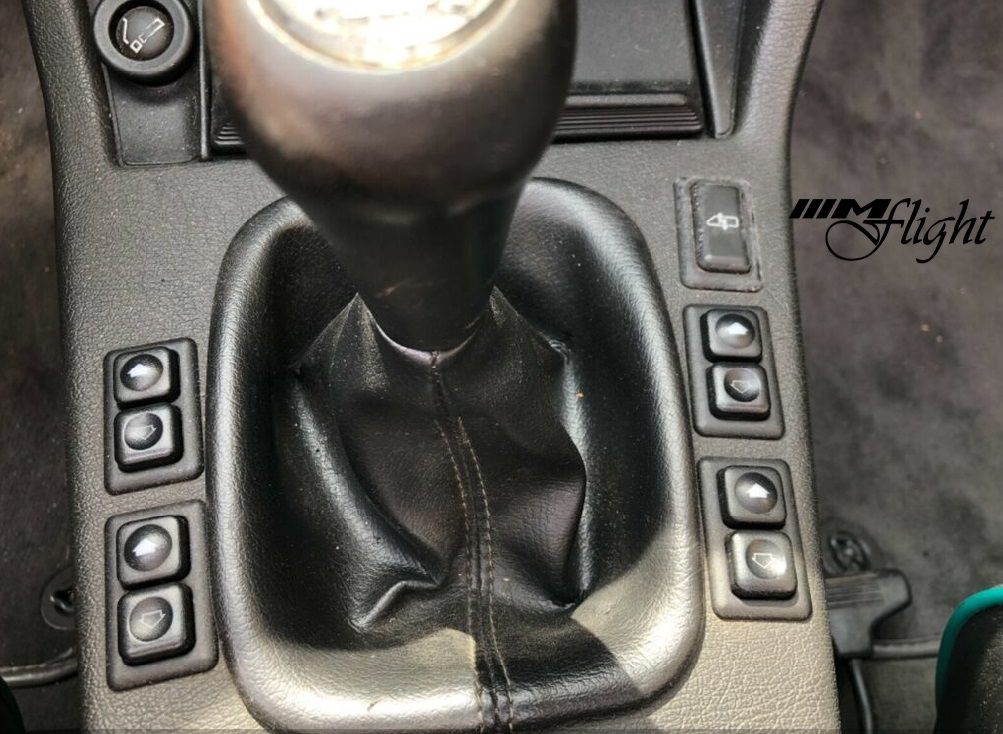 BMW E30 Design Edition green
BMW E30 Design Edition green
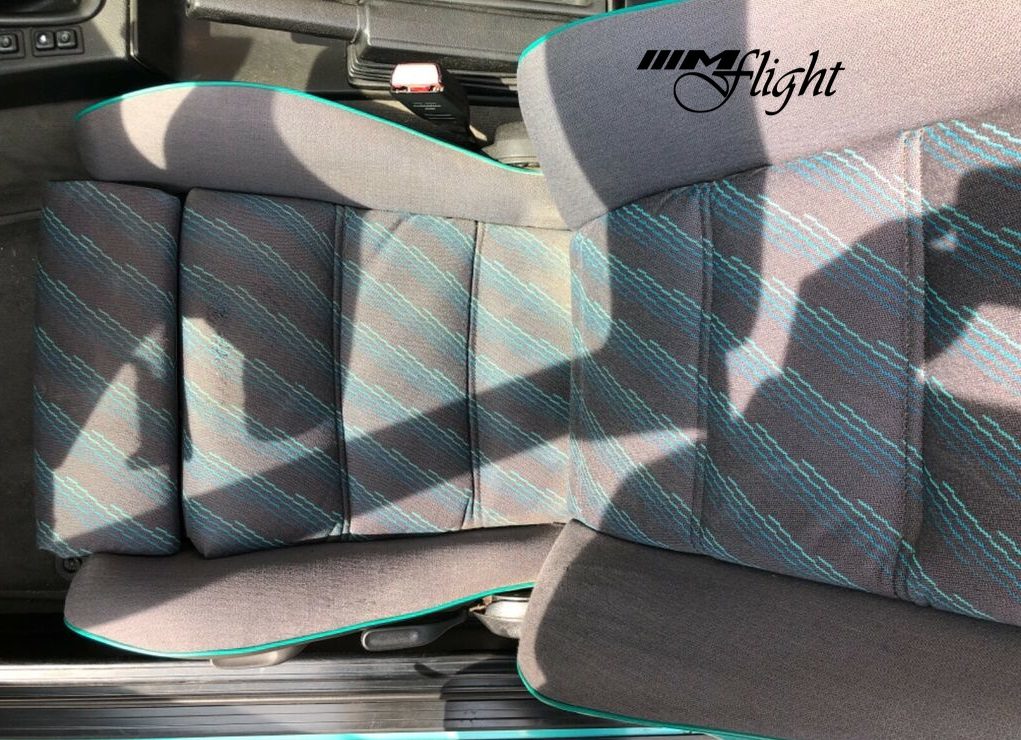 BMW E30 Design Edition green
BMW E30 Design Edition green

BMW E30 Design Edition
325i Convertible M-Technic Edition
In 1988 a special edition for the 325i Cabrio was launched, SA 791. This was in the special paint finishes Macao Blue Metallic or Nogaro Silver Metallic. The equipment was supplemented by an M-Technic chassis, 15 ″ cross-spoke wheels, an electro-hydraulic convertible top operation, Shadow-line and M-Technic leather sports steering wheel II including a leather gear knob. At the end of the construction period, BMW gave everything again. Here are the features of the Last Edition:
| S314A | FRONTSCHEIBENWASCHDUESEN BEHEIZT | Aussenspiegel / Fahrerschloss beheizt |
| S339A | SHADOW LINE | Shadow-Line |
| S350A | WAERMESCHUTZGLAS GRUEN, RUNDUM | Wärmeschutzglas grün |
| S377A | STOFFVERDECK ELEKT.MECH.DUNKEL | Verdeck elektromech. dunkel-blau |
| S428A | WARNDREIECK | Warndreieck und Verbandstasche |
| S510A | LEUCHTWEITENREGELUNG ABBLENDLICHT | Leuchtweitenregulierung |
| S655A | BMW BAVARIA C BUSINESS | Radio Bavaria C Business |
| S675A | BMW SOUND SYSTEM | Sound System |
| S680A | RADIOANTENNE MANUELL | Radioantenne manuell |
| S704A | M SPORTFAHRWERK | M Sportfahrwerk |
| S785A | NAPPA-TEXTIL WEBSTRUKTUR | Blinkleuchten weiss |
| S798A | M TECHNIC AUSSTATTUNG CABRIO |

BMW E30 Convertible M Technik Edition
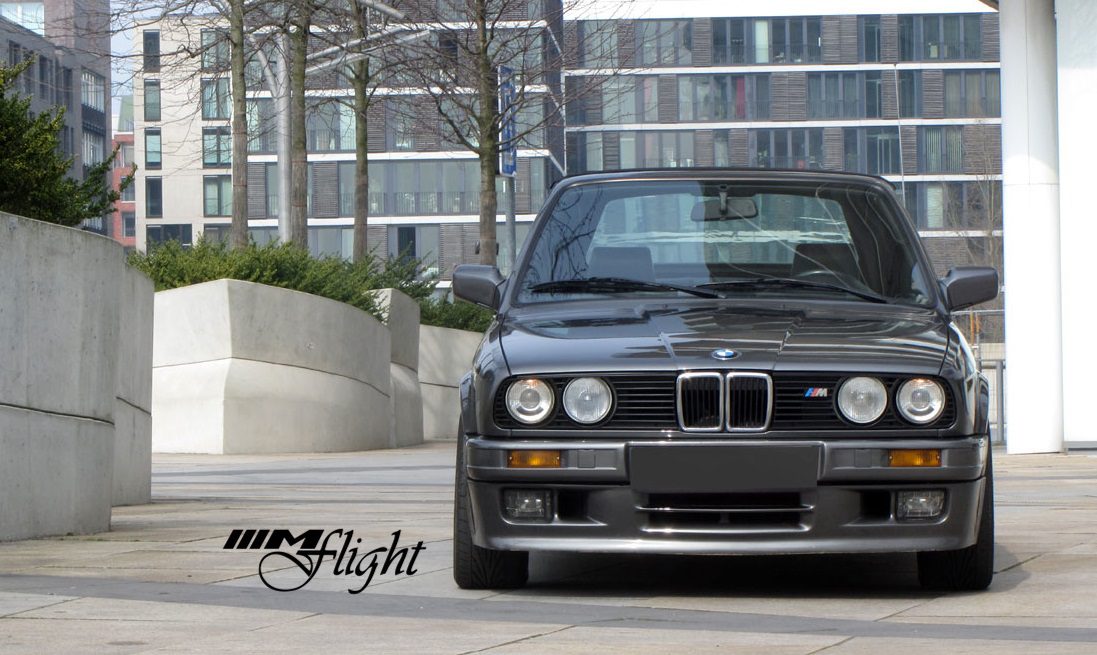
BMW E30 Convertible M Technik Edition

BMW E30 Convertible M Technik Edition

BMW E30 Convertible M Technik Edition
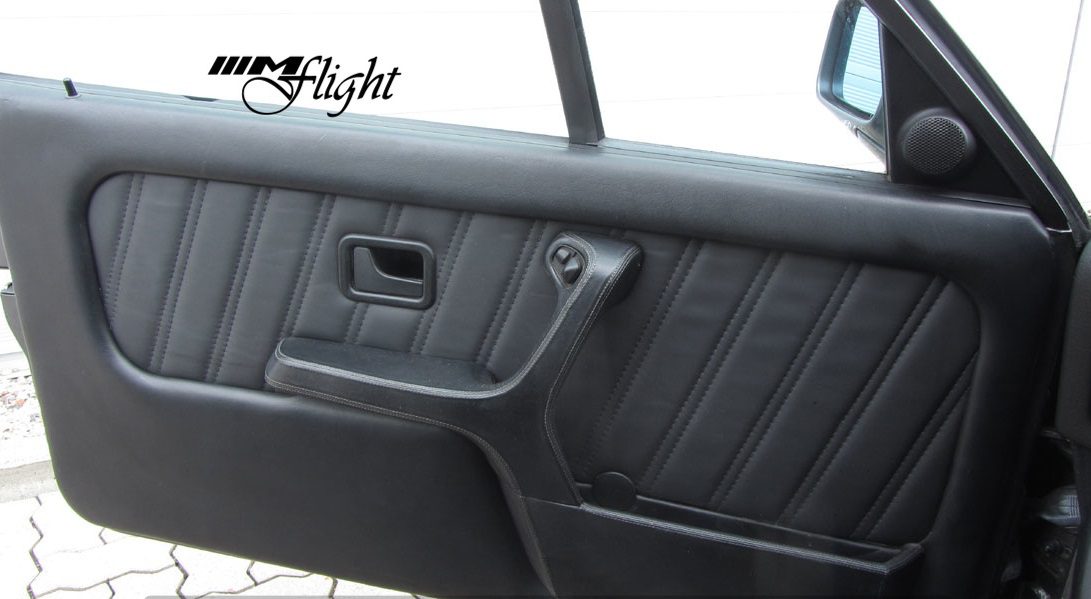
BMW E30 Convertible M Technik Edition
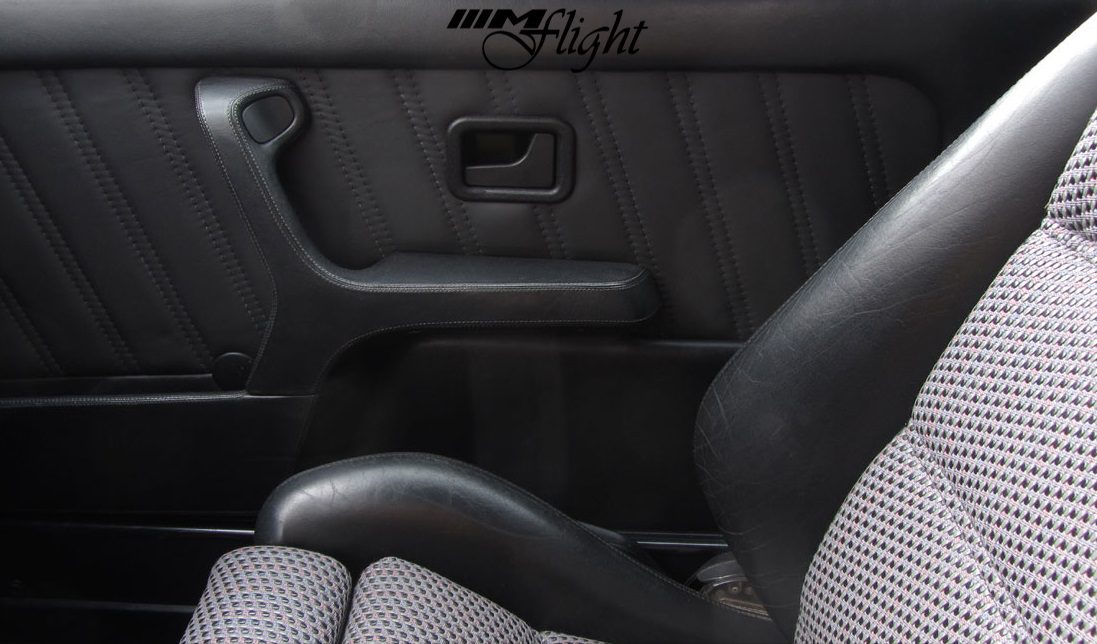
BMW E30 ConvertibleM Technik Edition

BMW E30 Convertible M Technik Edition
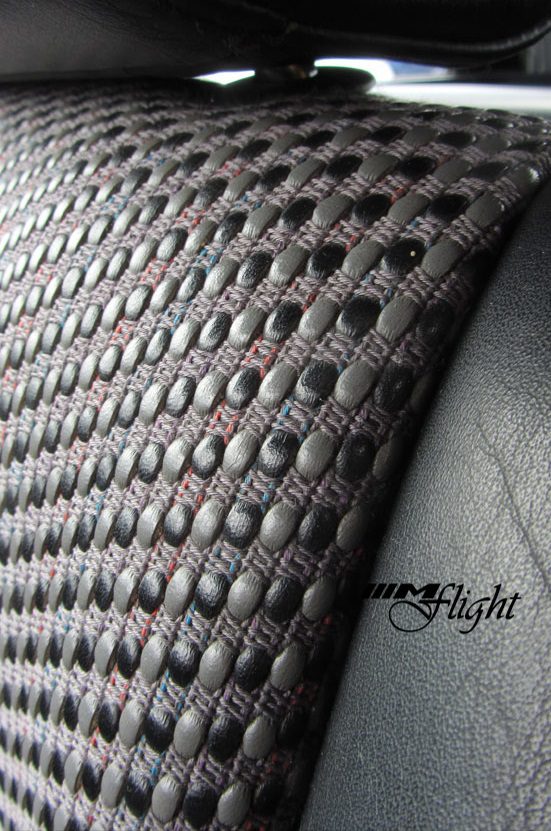
BMW E30 Convertible M Technik Edition
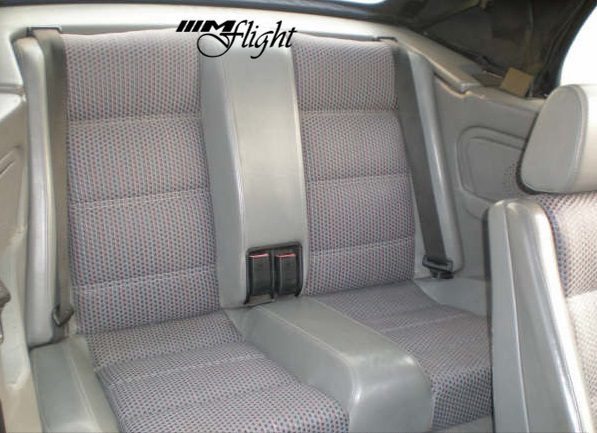
BMW E30 Convertible M Technik Edition

BMW E30 Convertible M Technik Edition

BMW E30 Convertible M Technik Edition
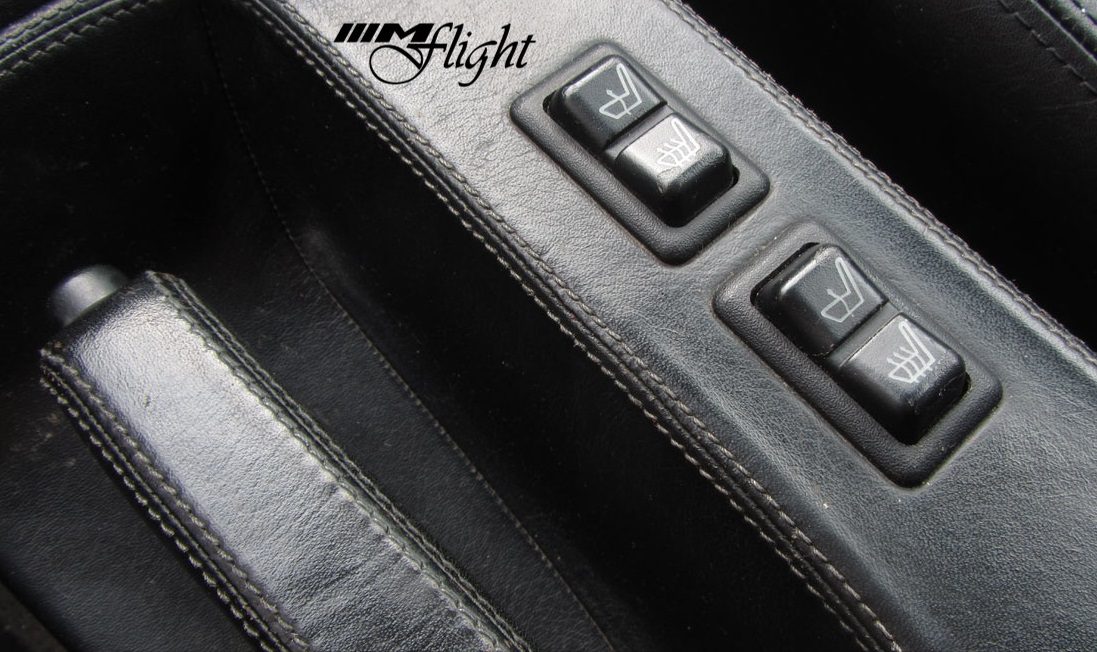
BMW E30 Convertible M Technik Edition
M-Technic Luxus-Edition
From June 1990 to October 1990, in addition to the M-Technic sports package, the 325i convertible was offered a significantly upgraded equipment for a limited period (not limited in number). Often the terms first or last edition are used for this.
In addition to the special paint finishes Macao Blue and Sebring Gray Metallic, the scope of equipment also included full leather appointments (doors, door pockets, door handles, side panels, center console, ashtray, convertible top compartment cover, steering wheel baffle plate, handbrake bag) in Walknappa black or silver. The seat center panels of the seat covers were made in a “nappa textile weave structure”. An electromechanical soft top operation, painted rim stars in Nogaro silver, a trunk lid panel and door sills with M-Technic lettering rounded off this extensive option.
From March to October 1991 there was another time-limited edition of this edition with identical features. In addition, the paint finishes lagoon green, Mauritius blue and calypso red metallic and lotus white as a third interior color were available.
This, I also call it that, “Last Edition” incl. M-Technic II sports package for a surcharge of DM 14,300. The package included a choice of the following colors:
a) Macao blue metallic
b) Sebgring gray metallic
c) Calypso red metallic
d) Lagoon green metallic
e) Mauritius blue metallic
and the following special equipment was also included:
special full leather interior, M-Technic chassis, steering wheel, 15 ” cross-spokes (star painted), e-top, M-Technic door sills, interior trim of the trunk lid
approx. 250 pieces.
In July 1992 a third, very small edition of this equipment package was delivered. There are 20 convertibles exclusively in alpine white II with lotus white equipment and should therefore be the smallest E30 special series ever.
The surcharge for the edition package was DM 14,300.
There was also a Motorsport Edition (320i and 325i)
Equipment packages
Shadow-Line:
This special equipment was introduced in Germany from the beginning of 1986. With the exception of the brand-specific kidney grille, all chrome parts were kept black and mirrors and bumpers were painted in the same color as the car. The choice of colors was always limited with this option. The paint finishes available were initially the metallic colors salmon silver, dolphin and diamond black. In 1988, Alpinweiß II and vermilion expanded this option. In 1989 salmon silver was replaced by sterling silver and vermilion was replaced by brilliant red. In 1991 dolphin silver was replaced by granite silver.
The models 318is, 320is two-door, M3 and the Touring (extended color selection for the Touring) were only available with Shadow-Line.
On special request, for models outside Germany and for almost all edition models, Shadowline was also combined with other colors.
Sports package:Until August 1987 there was a package for the 320i and 325e models with sportier technology (M-Technic chassis, 14 ″ aluminum wheels) and a modified exterior design (front and rear spoiler in body color, shadow line, metallic paint in diamond black, Salmon silver or dolphin, colored glazing green) available. From September 1987 this package was available as an option for the two- and four-door 320i and 324td sedans. For the US market, the two-door 325e models with sports package were named 325es, which also had electric windows, BC and the hi-fi system as standard.
M Technic sports package: The “M Technic” sports package was available for the 325i sedan up to August 1987, consisting of front and rear aprons, side skirts and a somewhat more voluminous two-part rear spoiler with a plastic insert that was also painted, mounted under the bumpers and painted in the vehicle color . Further equipment details such as Shadow-Line (limited choice of colors, see above), M Technic sport leather steering wheel, 15 ″ light metal rims in cross-spoke design with 205 / 55VR15 tires, “M Technic” sports suspension, green heat-insulating glass, sports seats, headliner in anthracite, Leather gear knob and bellows, an interior mirror with map reading lights and an automatic interior light rounded off this extensive option.
From September 1987, the “M Technic” sports package (also called “M-Technic II”) with the same scope of equipment was then optically adapted to the modified body (special front bumper, front apron, rear bumper with integrated apron, side panels on doors and fenders as well as Rocker panels and two-part rear wing) available for the 325i sedan.
From 1990 the “M Technic” package was also available for the 318is (in this case with fog lights that were standard on the 25 series), 325i Cabrio (also for the pre-facelift variant still being built as “M-Technic II”) and 325i Touring . In the course of this, the M Technic sport leather steering wheel was also replaced by the “M Technic II” sport leather steering wheel. The Touring had a larger roof spoiler instead of the small spoiler lip. Instead of the M-Technic sports suspension, which was not available for the Touring, it was only equipped with the standard suspension. For a further surcharge, “sporty chassis set-up with level control” was available for the Touring. Furthermore, the MT2 Touring was not equipped with “sky anthracite” like the MT2 Limos. In the Cabriolet, the interior mirror with reading lights and the rear spoiler were omitted, instead it was also available in Granite Silver Metallic. The two-door 320iS was always factory-fitted with the “M Technic” package.
Electric drive
BMW was already experimenting with battery-powered vehicles based on 1602 at the end of the 1960s. The heavy weight of the lead-acid batteries and the short range prevented further steps. In 1981 an electric car was tackled again, this time with a high-energy battery from the manufacturer ABB.

BMW E30 Limousine Elektro 1987

BMW E30 Limousine Elektro 1987
In 1987 there were the first mobile models based on the E30 as test vehicles with a 17kW DC motor. A 265kg battery pack with 22kWh based on sodium sulfur had three times the energy of lead batteries. Diesel heating ensured driving comfort even in winter. A range of 150km was possible and with a little run-up, a top speed of 100km could be achieved. 8 prototypes of the Elektro 325iX were built, which, by the way, were all front-wheel drive.

BMW E30 Limousine Elektro 1987
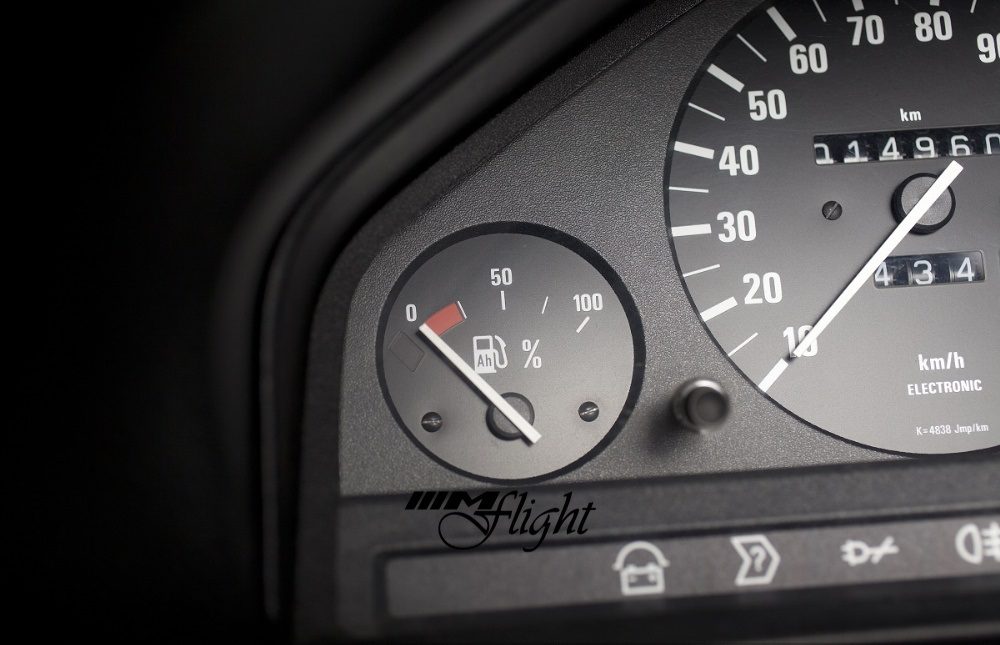
BMW E30 Limousine Elektro 1987
As part of the research project “Electric car with high-energy battery” (since 1981), eight BMW 325iX vehicles converted from all-wheel drive to front-wheel drive will be launched in 1987. They serve as a test vehicle for a new type of maintenance-free sodium-sulfur battery (NaS) that was developed by Asea Brown Boveri (ABB) specifically for use in an electric vehicle. The three times higher energy density than conventional lead batteries represents real progress, because for the first time there is a realistic perspective of reducing the specific disadvantages of electric drives such as battery weight and space requirements. In addition, all components of the electric drive are tested and further developed. For this purpose, BMW is building a special test bench with an integrated performance computer.
Also new is an electronic drive management system that regulates and controls charging at the socket, the flow of energy between the motor and battery and the thermal balance of the system. The complete control electronics are placed in a compact component carrier next to the motor. With the electrically powered BMW 3 Series, the project management decided for the first time to conduct an external test in everyday use. A BMW 3 Series touring proves its practical suitability in the delivery service of the Federal Post Office, other test vehicles are proving themselves as city automobiles with state authorities and municipalities. This is one of the reasons why the test vehicles are equipped with diesel hot water for heating the interior.

A test of whether series production makes sense seems to have been the aim of these prototypes. The cockpit is designed pretty perfectly.

Deutsche Post received an electrified E30 Touring for further tests